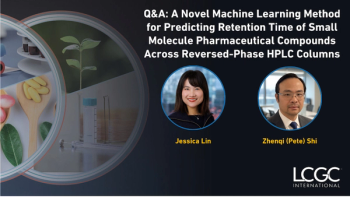
The Role of GC–MS in Caterpillar-Induced Plant Volatiles
The Column spoke to Ashraf El-Sayed from the Plant and Food Research Institute in Lincoln, New Zealand, about his research into caterpillar-induced plant volatiles and the role of gas chromatography–mass spectrometry (GC–MS) in his work.
TheColumn spoke to Ashraf El-Sayed from the Plant and Food Research Institute in Lincoln, New Zealand, about his research into caterpillar-induced plant volatiles and the role of gas chromatography–mass spectrometry (GC–MS) in his work.
Q. In 2016, your group published a study identifying caterpillar-induced plant volatiles that attract conspecific adult herbivores under natural conditions (1). What led your group to begin this study?
A:
We initiated a study in plant–insect interactions to investigate changes in the volatile organic compounds (VOCs) emitted from apple trees in response to infestation by leafroller larvae. Plants infested with herbivore larvae usually release herbivore-induced plant volatile compounds (HIPVCs) that attract natural enemies of the herbivores. Scientists call these volatile organic compounds a “cry for help” chemical signal. Our initial objective was to identify the chemical signal that attracts natural enemies. During our study, we discovered that these herbivore-induced plant volatile compounds not only attract natural enemies but also attract conspecific adult herbivores. This result was totally unexpected and raises many fundamental questions about the role of these compounds in plant–insect interactions.
Q. What were the main analytical challenges you encountered and how did you overcome them?
A:
The main analytical challenge we faced in this study was the detection of small molecules in the headspace samples. The standard dynamic volatile collection technique followed by solvent extraction and gas chromatography–mass spectrometry (GC–MS) analysis does not allow the detection of small molecules in the samples, because these compounds elute during the solvent delay of the GC–MS. However, the solid-phase microextraction (SPME) does not require a solvent delay. Therefore, various SPME fibres were tested for analysis of the headspace samples. This allowed us to have complete information about the composition of the headspace of infested and non-infested apple trees, and helped us in the identification of two molecules, acetic acid and acetic anhydride, that were critical for the biological assays.
Q: If plants are known to release volatiles as an indirect defence mechanism, why is it that no volatile signals that either repel or attract conspecific adults have been chemically identified in the field?
A: Most bioassays performed to date have been conducted in the laboratory. Very few studies have been conducted in the field. Even the studies that have been conducted in the field did not measure the direct response of herbivores to these compounds. Instead they measured the indirect response of herbivore to HIPVCs. A simple experiment testing HIPVCs in combination with the sex pheromone would demonstrate the repellency of these compounds. However, even these simple experiments were not conducted to show the repellency or the attraction under field conditions. Another possible explanation, scientists were unable to identify the correct chemical signal that can show an effect under field conditions. From our study, it seems that the difficulty in the identification of such chemical signal lies in its simplicity rather than in the complexity of chemical structures.
Q: Are there any external factors that must be taken into consideration when conducting this kind of investigation? What kind of controls need to be put in place?
A:
In field trapping experiments, there are several external factors that can affect the release rate and stability of the molecules in the releasing substrates. For example, small molecules like acetic acid will evaporate quickly in hot weather. This will affect the longevity of the lures. To combat this, we used high-density polyethylene vials with lids that had a 2-mm hole to control and regulate the release of acetic acid. As another example, we avoided placing 2-phenylethanol and benzyl alcohol in the same vials as acetic acid because this could result in the formation of the corresponding acetates through esterification.
Q: Were there any kind of issues with shipping the samples to be analyzed by GC–MS in dry ice? Was there potential for the samples to degrade in any way?
A:
Yes, there was potential for the samples to degrade. Most of the dry ice used to cool the samples that were sent from the USA to our laboratory evaporated during transportation. Luckily the samples were still good as indicated by the GC–MS analysis. In the future, we might use soft gel ice packs as these might have a longer-lasting cooling effect than dry ice.
Q. Why is GC–MS your technique of choice?
A:
The GC–MS technique has long been used in the identification and quantification of semiochemical compounds in chemical ecology research. It offers high specificity for structure determination and reliable quantitation of the compounds in insect or plant samples. It is suitable for the detection of volatile molecules, small molecules like acetic acid, benzenoid compounds, alcohols, terpenes, and sesquiterpenes in the headspace of plant and animal samples. Results are usually obtained as soon as sample analysis is complete. GC–MS can detect trace amount of compounds in headspace samples. Various types of capillary columns can be used to separate compounds in the headspace samples. This is very useful for confirmation of the chemical structures of unknown compounds. We have developed a great ability to operate various GC–MS machines and have been using this technique in our group for decades to identify semiochemicals (for example, sex pheromones, kairomones, and allomones) of plant or animal origin. In our study, the volatile organic compounds emitted from healthy and infested apple trees were analyzed and identified by GC–MS.
Q. What results did you find?
A:
We found qualitative and quantitative differences between the VOCs emitted by apple seedlings infested with leafroller larvae and the VOCs emitted by uninfested seedlings. Apple seedlings infested with tortricid larvae emitted seven VOCs (acetic acid, acetic anhydride, benzyl alcohol, benzyl nitrile, 2-phenylethanol, indole, and [E]-nerolidol) that were not released by uninfested trees. All seven compounds were in relatively low amounts compared to the much larger quantities of terpenes (for example, [E, E]-α-farnesene, [Z, E]-α-farnesene, germacrene D, β-caryophyllene, and linalool] present in the headspace of the infested apple trees. Six of the compounds unique to infested apple seedlings were tested in apple orchards in New Zealand, Canada, and the USA to identify a kairomone blend that significantly attracted conspecific adult herbivores. Binary blends of 2-phenylacetonitrile and acetic acid or 2-phenylethanol and acetic acid were the most attractive to male and female leafrollers. The catches of several leafroller males in traps baited with HIPVCs were surprisingly higher than the catches in sex pheromone traps, suggesting a potent biological activity for the identified HIPVCs. The literature published on plant-mediated multitrophic interactions between plants, herbivores, and natural enemies suggests a paradigm in which plants release a bouquet of HIPVCs upon feeding by herbivores. These HIPVCs have been implicated as foraging cues for natural enemies to locate herbivore hosts. Simultaneously, these HIPVCs deter conspecific herbivores. Such a system would enhance the plant’s defence against herbivore attack. The apple-mediated multitrophic interaction between plants and leafroller herbivores investigated in our study deviates from this scenario, with the chemical cues released from infested plants attracting the leafroller herbivores. These results suggest the general deterrent model of responses of adult herbivores to HIPVCs needs to be reevaluated. Furthermore, our identification of potent kairomones that attract both male and female leafrollers can greatly improve the applied use of semiochemicals for the control of these important cosmopolitan pests. Formulations containing both sex pheromones and kairomones could be tested for mass trapping or lure and kill tactics against these pests.
Q: What is your group working on next?
A:
Our study indicated that at least 13 different herbivore species in the order Lepidoptera respond to caterpillar-induced plant volatile compounds. These results suggest that this phenomenon is widespread among leaf feeding insects. At the moment, we are studying this phenomenon in insect groups other than moths. Preliminary results indicate that this phenomenon is widespread among insect groups other than moths (for example in leaf feeding Diptera). We will also investigate plant–plant interactions in regard to herbivore-induced plant volatile compounds.
Reference
1. A.M. El-Sayed, A.L. Knight, J.A. Byers, G.J.R. Judd, and D.M. Suckling,
Scientific Reports
6
, 37555 (2016).
Ashraf El-Sayed
is a senior research scientist at the Plant and Food Research Institute, Lincoln, New Zealand. He obtained his Ph.D. from the Department of Zoology, Zurich University, Switzerland, in 1997, and conducted postdoctoral research at the Swedish University of Agriculture Science in Sweden and at Agriculture and Agrifood Canada before joining Plant and Food Research in 2003. He has published over 80 peer review research papers on the chemical ecology of insects in various international journals. He is the author of The Pherobase, the world’s largest database of semiochemicals. E-mail: ashraf.el-sayed@plantandfood.co.nz Website: http://www.pherobase.com/authors/
Newsletter
Join the global community of analytical scientists who trust LCGC for insights on the latest techniques, trends, and expert solutions in chromatography.




